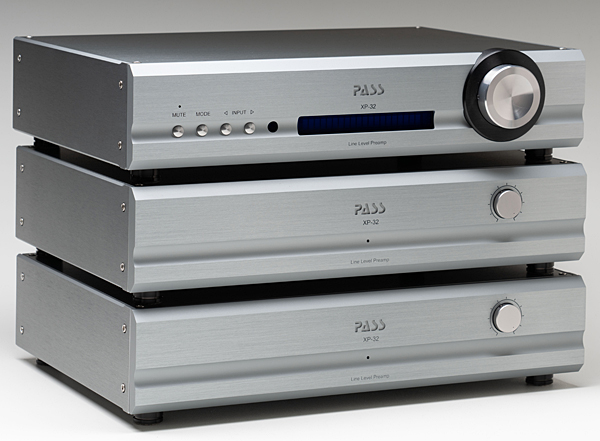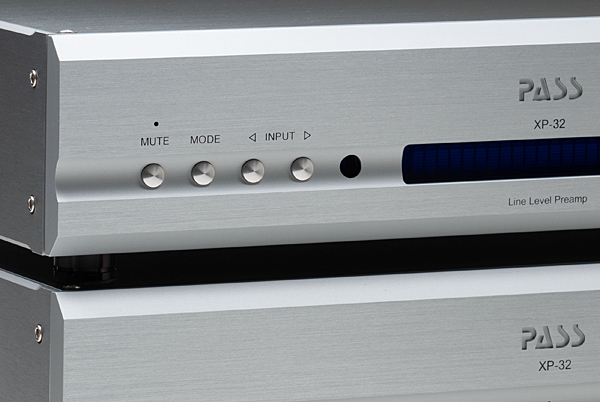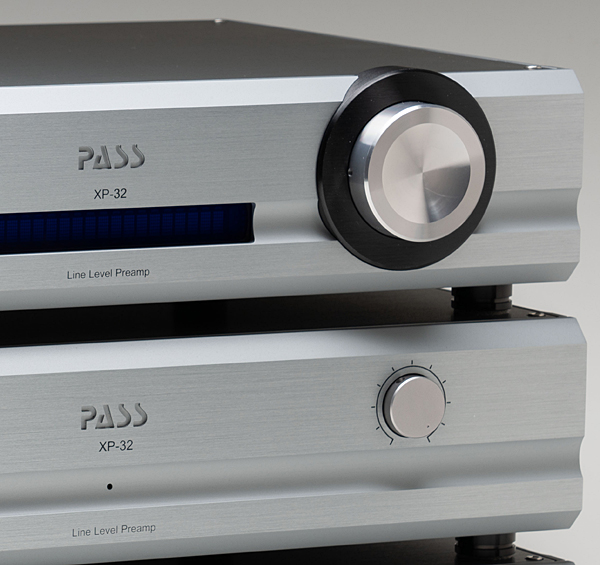| Columns Retired Columns & Blogs |
A frightening thought:
Can Pass whip up a 6 or 8 channel version of this?
Listening
After installing the XP-32, I used it for casual listening, internet radio stations and the like streamed with Roon, for a week, before I started serious listening with familiar music.

I started with Bravo!, the final recording I made at the Santa Fe Chamber Music Festival in 1998 (16/44.1 ALAC files, Stereophile STPH014-2). As I described in the CD booklet, I had had to close-mike all the instruments due to the fact that I wasn't allowed to turn off the new and noisy climate-control system in Santa Fe's Museum of Fine Arts. I had also recorded the performances with a pair of distant mikes and used those as my reference when I later synthesized the concert hall acoustic with a Lexicon digital reverberation unit and added that to the mix.
Listening to the first work on the album, Mozart's Piano Quartet No.1 in G Minor with Pinchas Zukerman playing the violin part, the XP-32 allowed every detail to be clearly presented. Very clearly, because, as the work progressed, I became increasingly aware of something I had never noticed before, even with the DAC feeding the power amplifiers directly: the piano, which had been behind the violin, viola, and cello on the stage, was positioned in front of them in the recorded soundstage.
Musically, this wasn't too odd, as the work could be considered a mini concerto for the piano. After some reflection, I realized what was happening: While I had placed the pair of microphones on the piano relatively close to the soundboard, the spot mikes were around 48" away from the string instruments, as this gave the most accurate representations of their tone. The XP-32's extraordinary transparency was allowing me to hear that enough of the real hall ambience was captured by each instrument's microphone that, when added to by the synthesized reverberation, it pushed the images behind the piano.

I followed the Mozart with another album from 1998 that has been in heavy rotation ever since it was recommended to me by Stephen Mejias a few years ago: the late Mark Hollis's eponymous album (16/44.1 ALAC files ripped from CD, Polydor), which built on his work with the band Talk Talk. With engineer Phill Brown, Hollis constructed carefully layered, atmospheric soundscapes, his plaintive vocals centered in front of double bass. Piano, acoustic guitar, and ostinato percussion are placed farther back in the soundstage with occasional solo-instrumental interjections at the sides.
When you stand in front of a truly great painting, the more you look the more you see. With the XP-32 in the system, each track on Mark Hollis had me sitting transfixed. The more I listened, the more I heard.
Some products appear to retrieve more detail from recordings by emphasizing high frequencies or transients, as if a spotlight was shining on the sound. This was not the case with the Pass Labs. Its superb retrieval of recorded detail was not accompanied by undue emphasis in the treble or longer-term listening fatigue. I played the MQA-encoded 24/48k FLAC file of "My Funny Valentine" from Radka Toneff's restored Fairytales album (Odin 9561), with Roon performing the first unfolding and the Grimm MU1 that I review elsewhere in this issue upsampling the 24/96 data to 24/192. I had only been intending to play this one track, but, entranced by the sound, I played the entire album.

This is the only track on Fairytales that had been originally recorded in analog, but even with the XP-32's transparency, I couldn't perceive any sonic discrepancy between this track and the ones that had been recorded digitally. Roon's Radio function followed Toneff with "How Do You Stop," from Joni Mitchell's overlooked—overlooked by me, that is—1994 album Turbulent Indigo (16/44.1k MQA-encoded FLAC, unfolded by Roon to 24/88.2 and upsampled by the MU1 to 24/176.4, Tidal/Reprise). Putting to one side the argument about whether a 16-bit PCM recording has enough spectral space beneath the music's noise floor to pack the 2Fs and 4Fs data, this track sounded magnificent, with Joni sounding natural, superb depth on the chiming electric guitars, and the bass guitar both rich and well-defined.
Wondering how much of what I was hearing was due to the Grimm's upsampling and how much to the XP-32's transparency, I switched off the upsampling, so that the DAC was receiving 24/88.2 data. The soundstage flattened, with less reverb apparent on the guitars and a slight edge now apparent to Joni's voice. The sound was still very good, but it had lost some of that magnificence. The XP-32 was readily letting me hear the improvement of the MU1's upsampling algorithm.
Comparing
I had two high-performance preamplifiers on hand with which to compare the Pass XP-32: the MBL N11 ($14,600) and the Benchmark LA4 ($2599) that had so impressed Kal Rubinson when he reviewed it in January 2020.
First up was the MBL, with sound pressure levels matched within 0.5dB at the listening position. (The N11 was set to its unity gain condition, which limits the maximum gain and which reviewer Jason Victor Serinus had preferred.) With the MBL N31 DAC in front of the preamplifier and the Parasound monoblocks behind it, the back-to-front soundstage on my Mozart Piano Quartet recording was as apparent as it had been on the XP-32, with as much image depth. The tonal balance, however, was a tad warmer and the presentation of acoustic objects within the soundstage was a little more—and how I hate using this word—palpable. For example, toward the end of the Joni Mitchell track, a high tenor voice appears in the center of the stage, floating slightly behind and slightly above Joni The MBL pushed this voice a little farther back than it had been with the Pass Labs, as well as a touch higher. A close-run thing, but like I said, more palpable.
Next up was the Benchmark. While the LA4 is considerably less expensive than the Pass XP-32 and MBL N11, its measured performance is on par with that of those two technical high-fliers. After an evening of warming up, the Benchmark had a somewhat upfront presentation in my system. Even with sound pressure levels matched, it sounded as if it was slightly louder than both the other preamplifiers. Detail like the reverberation on my Mozart recording was fully apparent with the LA4, but, paradoxically, soundstage depth was slightly more restricted than with the XP-32.
The images of the Mozart's violin, viola, and cello were well-defined laterally but were more in the plane of the piano image than behind it, as I had heard with the Pass Labs preamplifier. The Benchmark's reduction in soundstage depth was also apparent with Joni Mitchell's unfolded and upsampled "How Do You Stop." The LA4 is an excellent preamplifier, especially considering its price, but it was outclassed by the XP-32.
Summing up
A great preamplifier will allow through so much information, so much of the music, that the shortcomings of lesser speakers and amplifiers can be forgotten. The Pass Labs XP-32 satisfies that definition. It joins the Ayre KX-R Twenty, MBL N11, and, of course, the XP-30 in the ranks of great preamplifiers. I will miss the XP-32 when it goes back to the manufacturer at the end of the review period and return to my simpler, preamplifier-less system. But for the final two months of 2020's annus horribilis, I was privileged to enjoy my music library with more detail and correspondingly increased enjoyment than I expected, courtesy of the XP-32.

A frightening thought:
Can Pass whip up a 6 or 8 channel version of this?

Can Pass whip up a 6 or 8 channel version of this?
I believe you can add additional audio-channel chassis, each controlled by the same control unit.
John Atkinson
Technical Editor, Stereophile

John Atkinson wrote: I believe you can add additional audio-channel chassis, each controlled by the same control unit.
I was really thinking of the price tag and the rack space.

Didn't a prominent Stereophile editor once say that it was the preamp that was the most important part of a system?
;-D
It's out of my budget, but I love Nelson Pass.

I think Wayne Colburn does those.

Hm, I see Sonus Faber Lumina III used as speakers during the review. Does that mean we can expect the Lumina's to be reviewed sometime in near future? :)

Hm, I see Sonus Faber Lumina III used as speakers during the review. Does that mean we can expect the Lumina's to be reviewed sometime in near future? :)
My review of the Lumina III will be published in the April issue of Stereophile.
John Atkinson
Technical Editor, Stereophile

It's a pity that stereophile didn't review the SF sonetto line so we could make a direct comparison between both lines. However it's still good news to hear :)

Didn't you say that you returned it? Did you have to purchase it or is it on long term loan?
After I measured the MBL N11 for Jason's review, I arranged to hold on to the preamplifier first to use in my followup review of the MBL N31 CD player/DAC in the December 2020 issue, then to use as a reference for this Pass Labs review. It has since been shipped to another Stereophile reviewer to use as a reference for a review of another product.
John Atkinson
Technical Editor, Stereophile

I once connected my Wadia 781 directly to my power amplifiers (Pass X 600). The sound is much better with my preamplifier (Audio Research Ref 5) in between!

I know what you mean:
I once connected my Wadia 781 directly to my power amplifiers (Pass X 600). The sound is much better with my preamplifier (Audio Research Ref 5) in between!
I gave up on finding a suitable preamp since I need 8 channels. I run my DACs directly to my power amps and it is, indeed, much better.

I have some trouble looking at the signal to noise specs. The claim is 150 dB at max output voltage, and 500 nV residual noise, which is more or less what you expect with an output voltage of 23V and 150 dB S/N.
However JA measured 85 dB at 1 V. At 23 V we should then expect 27 dB more which is 112 dB, a whopping 38 dB less (a factor of 80). This would result in a residual noise of 56 mV, more than a factor of 100 higher, Even with bandwidth restriction and A-weighting the measured S/N reaches "only" 124 dB, 26 dB less than claimed.

The SN ratio was calculated from max output of 32 Volts with 1uV as the noise. The noise floor is actually lower than 1uV. It all depends how you measure it and the reference. Of course we spec it to look good, the suns output would make a good max reference. Measured on the AP with a 30 KhZ filter it is about 14 uV broadband. John's AP FFT show -120 to -140 dB range. 56 mV would be rather crappy, its a very quiet preamp.

Aah, there is a typo on the specification page: 23 V max (correct is 32 V). So my calculations are 3 dB off.
14 uV noise broadband (30 kHz) is almost 30 times more than the specified 0.5 uV. May I ask under which conditions you did measure those 0.5 uV?
Regarding JA's FFT plot: one have to keep in mind that the FFT noise floor does not show the S/N value. You have to subtract the FFT gain (3dB per doubling of bin size) to get the real value. I don't know the FFT size of JA's FFT plot. With 16k FFT size the FFT gain is 39 dB. Subtracting 39 dB from 120 - 140 dB we get 81 - 101 dB which correlates quite well with JA's measured S/N.

I hope you don't mind if I point out that your turntable setup is perhaps getting a bit long in the tooth? I love the Linn and all that but at lot has happened since 1991 even in Linn world. That old MDF tone arm board is not exactly known for it's high resolving power. Could it be that your digital setup is outresolving your turntable in the time domain and perhaps that would not be the case with a modern turntable or even an up to date Linn?

I hope you don't mind if I point out that your turntable setup is perhaps getting a bit long in the tooth? I love the Linn and all that but at lot has happened since 1991 even in Linn world...
Indeed it has, but I am so familiar, so comfortable, with the sound of my LP12-based LP system that I fear change.
John Atkinson
Technical Editor, Stereophile

Why on earth would you not want to run the pre Amp Direct , favoring the sound of caps maybe ..??
Btw JA ,
Are those stereophile CD’s mentioned still available ..??
Regards

Are those stereophile CD’s mentioned still available ..??
Yes, see http://shop.stereophile.com/music-cds/
John Atkinson
Technical Editor, Stereophile

Looking at my test CDs, I found, with no jewel box, cover art, or record of purchase, Stereophile CD STPH-002-2. It was apparently the first test CD Stereophile made, released in 1990.

I suggest a follow up to address those coupling caps.
"The output is still capacitor-coupled even with the servo but can be bypassed with internal jumpers."
On the back panel - "no user serviceable parts"
Question for Wayne - why not have jumpers accessible to the exterior? Note all those XLR jack jumpers/
(good photos BTW)